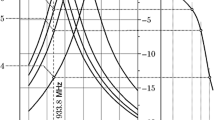Abstract
A brief review of microwave techniques for measuring solid-propellant burning rate is given, and the principles of the techniques are described. A burning-rate meter operating in the 2-mm microwave band, which was designed by the authors, is described, and tentative results obtained using this device are reported. Limitations of the method, sources of errors, and problems related to the choice of the microwave band and measurement systems are discussed. Problems that should be solved to increase the accuracy and reliability of burning-rate measurements using microwave techniques are considered.
Similar content being viewed by others
References
V. E. Zarko and K. K. Kuo, “Critical review of methods for regression rate measurements of condensed phase systems,” in: K. K. Kuo and T. Parr (eds.)Nonintrusive Combustion Diagnostics, Begel House, New York (1994), pp. 600–623.
L. D. Strand, K. R. Magiawala, and R. P. McNamara, “Microwave measurement of solid-propeliant pressure-coupled response function,”J. Spacecraft,17, No. 6 (1980).
D. T. Foss, R. J. Roby, and W. F. O’Brien, “Development of dual-frequency microwave burn-rate measurement system for solid rocket propellant,”J. Propuls. Power,9, No. 4 (1993).
P. Venugopalan, K. A. Jose, K. G. Nair, et al. “Microwave method for locating inhomogeneities in cured rocket propellant samples,”NDT Int.,19, No. 6 (1986).
B. Koch, “Reflexion de micro-ondes par des phenomenes de detonation,”C. R. Acad. Sci. Paris.,236, 661–663 (1953).
M. A. Cook, R. L. Doran, and G. J. Moris, “Measurement of detonation velocity by the Doppler effect at the three-centimeter wavelength,”J. Appl. Phys.,26, No. 3 (1955).
G. F. Cawsey, J. L. Farrands, and S. Thomas, “Observations of detonation in solid explosives by microwave interferometry,”Proc. Roy. Soc. London. Ser. A,248, (1958), pp. 199–521.
D. L. Johnson,Microwave Measurement of the Solid Propellant Burning Rates, Giannini Controls Corp., Duarte (1962).
R. B. Cole, “High pressure solid propellant combustion studies using a closed bomb,” Rohm and Haas Co., Rept. S-68, Contract DA-01-021 ord-11, 909(Z), October, Huntsville, AL (1965).
D. S. Dean and D. T. Green, “The use of microwaves for the detection of flaws and measurement of erosion rates in materials,”J. Sci. Instrum.,44, No. 9 (1967).
H. L. Wood, W. F. O’Brien, and C. B. Dale, “Measurement of solid propellant burning rates employing microwave techniques,” in:Proc. of the 6th Int. Symp. on Air Breathing Engines, Paris, France (1983).
J. Gittins, R. D. Gould, P. D. Penny, and P. C. Wellings, “Solid propellant combustion instability,”J. British Interplanet. Soc.,25, No. 6 (1972).
H. L. Wood and W. F. O’Brien, Progress Report, NASA Research Grant NGR 47-004-024, Virginia Polytech. Inst. Blacksburg (1968).
H. L. Wood, Final Report, NASA Grant NGR 47-004-024, Virginia Polytech. Inst., Blacksburg (1970).
B. A. Anicin, B. Jojic, D. Blagojevic, et al., “Flame plasma and the microwave determination of solid propellant regression rates,”Combust. Flame,64 (1986).
V. S. Bozic, D. D. Blagojevic, and B. A. Anicin, “Measurement system for determining solid rocket propellant burning rate using reflection microwave interferometry,”J. Propuls. Power,13, No. 4 (1997).
V. S. Bozic, D. D. Blagojevic, and B. A. Anicin, “Measurement system for determining solid propellant burning rate using transmission microwave interferometry,”J. Propuls. Power,14, No. 4 (1998).
S. V. Shelton, “A technique for measurement of solid propellant burning rates during rapid pressure transients,” in: Bulletin of the 4th ICRPG Combustion Conference, CPIA Publication No. 162, Vol. I, Silver Spring (1967), pp. 361–372.
A. Alkidas, A. Clary, G. Giles, and S. Shelton, “Measurement of steady state and transient solid propellant burning rates with microwaves,” Final Report, Georgia Inst. of Technology, U. S. Air Force Office of Scientific Research 70-1934, Atlanta (1973).
L. D. Strand, A. L. Schultz, and G. K. Reedy, “Microwave doppler shift technique for determining solid propellant transient regression rates,”J. Spacecraft Rockets,11, No. 2 (1974).
L. D. Strand and R. P. McNamara, “A variable-frequency driver-microwave transient regression rate measurement system,” in: T. L. Boggs and B. T. Zinn (eds.),Progress in Astronautics and Aeronautics, Vol. 63:Experimental Diagnostics in Combustion of Solids (1978), pp. 155–172.
Author information
Authors and Affiliations
Additional information
Translated fromFizika Goreniya i Vzryva, Vol. 36, No. 1, pp. 68–78, January–February, 2000.
This work was supported by Brigham Young (USA, project leader Prof. M. Beckstead) and the Federal program “Integration” (Grant No. 1080K).
Rights and permissions
About this article
Cite this article
Zarko, V.E., Vdovin, D.V. & Perov, V.V. Methodical problems of solid-propellant burning-rate measurements using microwaves. Combust Explos Shock Waves 36, 62–71 (2000). https://doi.org/10.1007/BF02701515
Received:
Issue Date:
DOI: https://doi.org/10.1007/BF02701515




